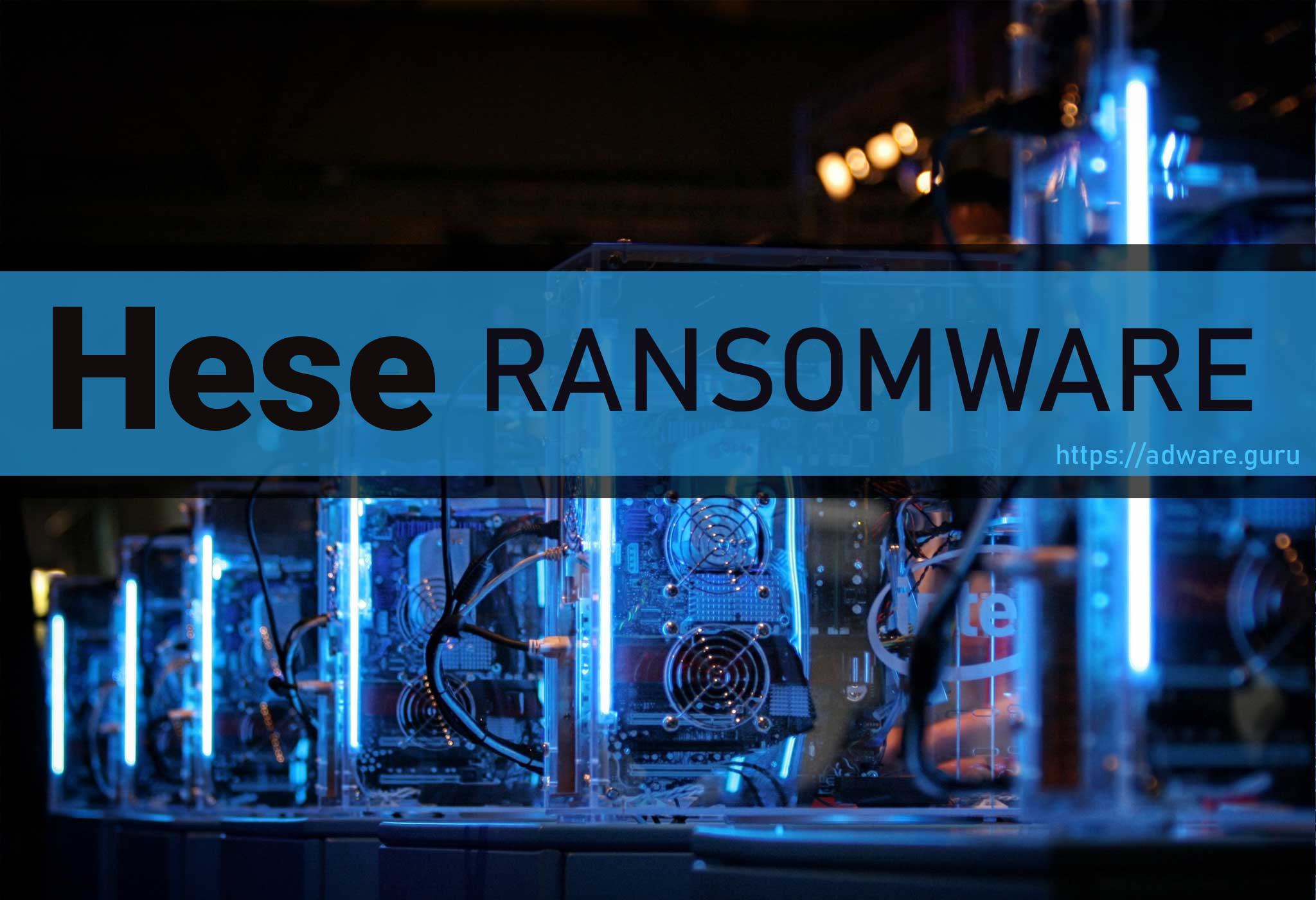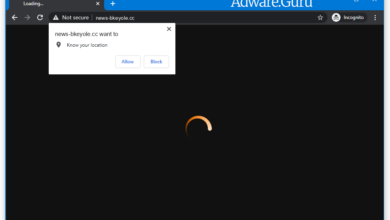Hese Virus Removal Guide (+Decrypt .hese files)
Hese Virus – Details
Hese is a destructive software working as common ransomware. Michael Gillespie, the well-known malware researcher, very first discovered this new name in the DJVU ransomware family.
Hese was developed for the sole purpose to encrypt all popular file types. Logically, as quickly as the file encryption is successfully achieved, the users are unable to get access to them. Hese ransomware includes its own “.hese” to all the encrypted files. For example, the file “price_list.xls”, once modified by Hese, will be entitled as “price_list.xls.hese”. As soon as the encryption is achieved, Hese puts its own unique text document (_readme.txt) into all the folders that store the encrypted files.
The alert stated by document requesting the random os very similar to the alerts given by other ransomware threats belonging to the DJVU family. The caution essentially shows that the information has been encrypted and the only option to get access to it is to use a distinct standalone key. Regretfully, this statement is absolutely real.
The method to secure the files used by Hese is not completely investigated. However, there is no doubt that each computer system owner might be released a special decryption key, which is absolutely distinct. It is extremely difficult to recover the data without the appropriate type in location.
“Don’t worry, you can return all your files!”, from text file message:
One more peculiarity of the Hese ransomware is that the users are not able to get access to the key. The decrypting key is hosted on a special server under the complete control by the scoundrels who have actually released the Hese virus into the web. In order to get the key and restore the important information, the users are told to get in touch with the frauds via email or by telegram and to pay the ransom in the amount of $980.
The message also states that the people must contact the Hese authors within 72 hours upon the minute of the information encryption. The alert indicates that by doing so the people will get a 50% discount, for that reason, the ransom quantity drops down to $490.
Hese crypted your files, however, it may not be the only danger on your computer. Plus, the ransomware might be hidden deep in the system. To detect and erase the threat completely, we suggest you to describe the help of GridinSoft Anti-Malware tool.
Download GridinSoft Anti-Malware
GridinSoft Anti-Malware Review, How to get free trial?, EULA, and Privacy Policy.
No matter what the quantity of the ransom is, we highly recommend that you do not pay the ransom. There is no assurance that these online criminals will keep their guarantees, so they may not care at all what the victims feel about the file encryption, even when the quantity of the ransom is gotten into their accounts. Thus, paying ransom often does not lead to a successful recovery. So, the users may just lose their money for nothing.
Likewise, we advise you not to contact the scams as they advise. Do not transfer loan into their wallets. There are no applications that could split the Hese ransomware or bring back the data at no charge. Therefore, the only correct choice is to bring back the information from possible backups (if offered).
Virus Summary
| Name | Hese Ransomware |
| File Extension | hese |
| Type | Ransomware |
| Family | DJVU |
| Short Description | The ransomware encrypts all the data stored on your system and requires a ransom to be paid on your part supposedly to recover your important files. |
| Symptoms | File encryption by the ransomware is performed by means of the AES-556 algorithm (CFB mode) encryption algorithm. Once the encryption is completed, the ransomware adds its special .hese extension to all the files modified by it. |
| Distribution Method | Adware bundles and software cracks |
| Similar Infections | Carote, Stare, Cetori |
| Removal Tool | GridinSoft Anti-Malware |
Do not forget that the Internet is now filled with infections similar to the Hese virus. For example, this specific hazard is essentially similar to Brusaf and other ransomware-type infections. These harmful utilities have actually been developed in order to secure the important information and express the demand for the users to pay the ransom. All these infections use the identical algorithm to produce the particular key for effective files decryption.
Unless the Hese ransomware is still under the development process or has actually got some concealed bugs, it is not possible to restore the data by hand. Therefore, the only working solution to avoid the loss of your crucial data is to regularly maintain up-to-date backups of all your crucial files.
Another essential piece of advice is to store the backups on unique storage not connected to your main device. For example, you may save it on the USB Flash Drive, or some external hard disk drive, or by using the cloud data storage services. Keeping the backups on your routine drive is really dangerous, since the backup might likewise be secured by the Hese .
Leakages for the Hese ransomware attack.
Hese utilizes many paths to infiltrate the vulnerable computer systems. It is not particular what specific method was utilized in your case, nevertheless, the intrusion might take place via the following channels:
- bundling with third-party programs, mainly free software;
- spam e-mails from the unknown senders;
- sites supplying complimentary hosting;
- P2P (peer-to-peer) torrent software.
There are times when the Hese ransomware might camouflage itself as some genuine application, for example, through the deceptive notifies requiring installation of some software application upgrade. This is the most typical technique utilized by the scams to inject the Hese virus files into the system. In this manner users partly take part in its installation, without plainly understanding the danger.
Moreover, the frauds might send unsolicited spam email with difficult signals encouraging the people to open dubious attachments or click on some download links, for example, those motivating the people to open particular pictures, text files, tax documents and other information.
No doubt, opening these files or clicking the harmful links might basically damage the system. Fake Media Player update alerts may lead to the Hese ransomware seepage. Similarly, downloading the cracked software might in addition include the ransomware installer. The last but not the least, installation of Hese may happen through some Trojan horses that may be set up stealthily into the system and without the user’s direct permission or perhaps permission.
Avoiding the Hese ransom virus injection.
Obviously, there is no outright guarantee that your computer will be constantly free of any malware attacks, however, we want to share some helpful tips with you to make it safer. Ensure to pay extremely very close attention while browsing the web and specifically while getting cost-free programs. Do not open any dubious e-mail accessories, especially if the sender is not known to you.
Do not forget that specific freeware installer might likewise consist of some other additional apps in the bundle. These additional applications may be extremely damaging. It is of utmost significance to keep your anti-virus software application and your operating system in general to be constantly effectively upgraded.
It is quite rational that downloading cracked programs is illegal, however, additionally, such unapproved software use might likewise bring major damage to your PC. Hence, do not download any cracked programs. Plus, the truth that your existing anti-virus did not safeguard the system from the Hese ransomware is a great factor for you to reconsider your choices and change to another program that can render the protecting functions on a better level.
Below please find the quotation from the Hese text file:
ATTENTION! Don't worry, you can return all your files! All your files like photos, databases, documents and other important are encrypted with strongest encryption and unique key. The only method of recovering files is to purchase decrypt tool and unique key for you. This software will decrypt all your encrypted files. What guarantees you have? You can send one of your encrypted file from your PC and we decrypt it for free. But we can decrypt only 1 file for free. File must not contain valuable information. You can get and look video overview decrypt tool: https://we.tl/t-2P5WrE5b9f Price of private key and decrypt software is $980. Discount 50% available if you contact us first 72 hours, that's price for you is $490. Please note that you'll never restore your data without payment. Check your e-mail "Spam" or "Junk" folder if you don't get answer more than 6 hours. To get this software you need write on our e-mail: [email protected] Reserve e-mail address to contact us: [email protected] Our Telegram account: @datarestore
Screenshot of files with “.hese” extension added by the ransomware:”

Use GridinSoft Anti-Malware to remove Hese ransomware from your computer
1.Download GridinSoft Anti-Malware.
You can get GridinSoft Anti-Malware by clicking the button below:
2. Double-click on the setup file.
When setup file has finished downloading, double-click on the setup-antimalware-ag.exe file to install GridinSoft Anti-Malware on your computer.

An User Account Control asking you about to allow GridinSoft Anti-Malware to make changes to your device. So, you should click “Yes” to continue with the installation.

3. Press Install button for run GridinSoft Anti-Malware.
3.Once installed, GridinSoft Anti-Malware will automatically run.
4. Wait for the GridinSoft Anti-Malware scan to complete.
GridinSoft Anti-Malware will automatically start scanning your computer for Win Speedup 2018 and other malicious programs. This process can take a 20-30 minutes, so we suggest you periodically check on the status of the scan process.

5. Click on “Clean Now”.
When the scan has completed, you will see the list of infections that GridinSoft Anti-Malware has detected. To remove them click on the “Clean Now” button in right corner.









